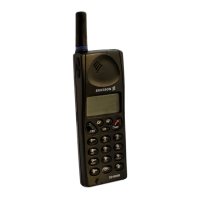1 Space-?!,.:“'()1
2 ABCÅÄÆàÇ2Γ
3 DEFèÉ3∆n
4 GHIì4
5 JKL5Λ
6 MNOÑÖØò6
7 PQRSß7Π Σ
8 TUVÜù8
9 WXYZ9
0 0+&@/$%£Θ Ξ Ψ Ω
# #*
Note! To enter a digit, you can also press and hold down the
numeric key.
How to Enter Lower-Case Letters
•
Enter the letter, for example an ‘A’, and then press *.An‘a’
appears.
Lower-case letters will now appear until you press * again.
The CHECK and SPECIAL CHARACTERS Menus
If you have entered characters into the display, the SPECIAL
CHARACTERS MENU will appear in the display when you enter the
menu system by pressing the right arrow. If you have entered more
than 20 characters into the display, the
CHECK menu appears when
you enter the menu system by pressing the right arrow.
How to Check the First Characters
If you enter more than 20 characters (0–9and*,#, + or p) into
the display, the first characters will disappear from the display.
Instead, a left arrow is shown to the left in the second line, in front
of the characters.
Pressing the right arrow takes you to the
CHECK menu, which lets
you see the first characters you have entered.
If you wish to enter a special character, press the right arrow. To
return to the standby display, press the left arrow.
How to Insert Special Characters
If you have entered fewer than 20 characters , pressing the right
arrow takes you directly to the
SPECIAL CHARACTERS menu.
This menu makes it possible to:
• Insert a pause character (p) to separate the phone number from a
code that you wish to send as DTMF tones. See DTMF Tones,
p. 34.
•
Insert a code that shows your phone number in the receiver’s
phone display when making a call. See Who Is Calling?, p. 36.
•
Insert a code that hides your phone number when making a call.
See Who is Calling?, p. 36.
EN/LZT 126 1353 R1B 13

